Price remains above the invalidation point, finding support at the trend line on the main daily Elliott wave count.
Summary: It would be my judgement today that classic analysis mostly supports the main daily wave count.
A new high now above 1,234.76 would add reasonable confidence that a low is in place, but prior to that it will remain possible that a new low may occur before a trend change.
The short term volume profile is now bullish. This supports the main daily Elliott wave count.
At the end of last week, On Balance Volume makes new lows at the weekly and daily chart levels. This is very bearish and supports the alternate daily Elliott wave count. If the target at 1,211 is wrong, it may not be low enough. A classic analysis target is about 1,160.
Always trade with stops to protect your account. Risk only 1-5% of equity on any one trade.
New updates to this analysis are in bold.
Grand SuperCycle analysis is here.
Last historic analysis with monthly charts and several weekly alternates is here, video is here.
Last remaining four weekly wave counts were updated here, and video here.
MAIN ELLIOTT WAVE COUNT
WEEKLY CHART – TRIANGLE
There are four remaining weekly wave counts at this time for cycle wave b: a triangle, flat, combination or double zigzag. At this stage, all four expect a bounce over the next few weeks, and the triangle has the best look.
While the direction does not diverge for these four weekly wave counts, only one weekly wave count shall be published on a daily basis, so that the analysis is manageable for me to publish and for members to digest. Note: This does not mean that the remaining three counts may not be correct.
The triangle so far has the best fit and look.
Cycle wave b may be an incomplete triangle. The triangle may be a contracting or barrier triangle, with a contracting triangle looking much more likely because the A-C trend line does not have a strong slope. A contracting triangle could see the B-D trend line have a stronger slope, so that the triangle trend lines converge at a reasonable rate. A barrier triangle would have a B-D trend line that would be essentially flat, and the triangle trend lines would barely converge.
Within a contracting triangle, primary wave D may not move beyond the end of primary wave B below 1,123.08. Within a barrier triangle, primary wave D may end about the same level as primary wave B at 1,123.08, so that the B-D trend line is essentially flat. Only a new low reasonably below 1,123.08 would invalidate the triangle.
Within both a contracting and barrier triangle, primary wave E may not move beyond the end of primary wave C above 1,365.68.
Four of the five sub-waves of a triangle must be zigzags, with only one sub-wave allowed to be a multiple zigzag. Primary wave C is the most common sub-wave to subdivide as a multiple, and this is how primary wave C for this example fits best.
Primary wave D must be a single structure, most likely a zigzag. It is possible that primary wave D could be over.
One triangle sub-wave tends to be close to 0.618 the length of its predecessor; if primary wave D is over at last week’s low, it is just 3.64 below this point.
There are no problems in terms of subdivisions or rare structures for this wave count. It has an excellent fit and so far a typical look.
DAILY CHART – TRIANGLE
It is possible that primary wave D is over. The structure may be seen complete.
Primary wave E must subdivide as a single corrective structure, most likely a zigzag. Within the zigzag, intermediate wave (A) would most likely be an impulse.
Minor waves 1 and 2 may now be over, and some increase in upwards momentum may now be expected for minor wave 3. Minor wave 2 has tested support at the lower triangle trend line; this has a typical look.
At this stage, the best target calculation for primary wave E would be 0.618 the length of primary wave D. This yields a target that is within a very strong area of resistance.
When intermediate waves (A) and (B) within primary wave E may be complete, then the ratio between intermediate waves (A) and (C) may be used to add to the target calculation at a second degree. At that stage, it may change or widen to a zone.
Primary wave E would be most likely to fall reasonably short of the A-C trend line.
In the first instance, primary wave E may be expected to last about a Fibonacci 21 weeks. It is also possible that it may not last that long because E waves of a triangle can be relatively quick.
HOURLY CHART
Minor wave 2 fits as a regular flat correction.
Minor wave 3 must subdivide as an impulse, should exhibit an increase in upwards momentum, and have support from volume. Within minor wave 3, minute wave ii may not move beyond the start of minute wave i below 1,215.22.
A target is calculated for minor wave 3 to end, which expects it to exhibit the most common Fibonacci ratio to minor wave 1.
This wave count still requires a new high above 1,234.76 for confidence.
DAILY CHART – TRIANGLE – ALTERNATE
It is possible that primary wave D is not over and one final new low may complete it.
Within the impulse of intermediate wave (C), minor wave 3 is shorter than minor wave 1. Therefore, minor wave 5 is limited to no longer than equality in length with minor wave 3, so that the core rule stating a third wave may not be the shortest wave would be met.
Minor wave 5 may be incomplete, and within it minute wave iv may now be a complete zigzag.
If the target at 1,211 is wrong, then it may not be low enough. At the end of last week, On Balance Volume has made new lows at both the daily and weekly time frames, which when combined is a very bearish signal.
TECHNICAL ANALYSIS
WEEKLY CHART
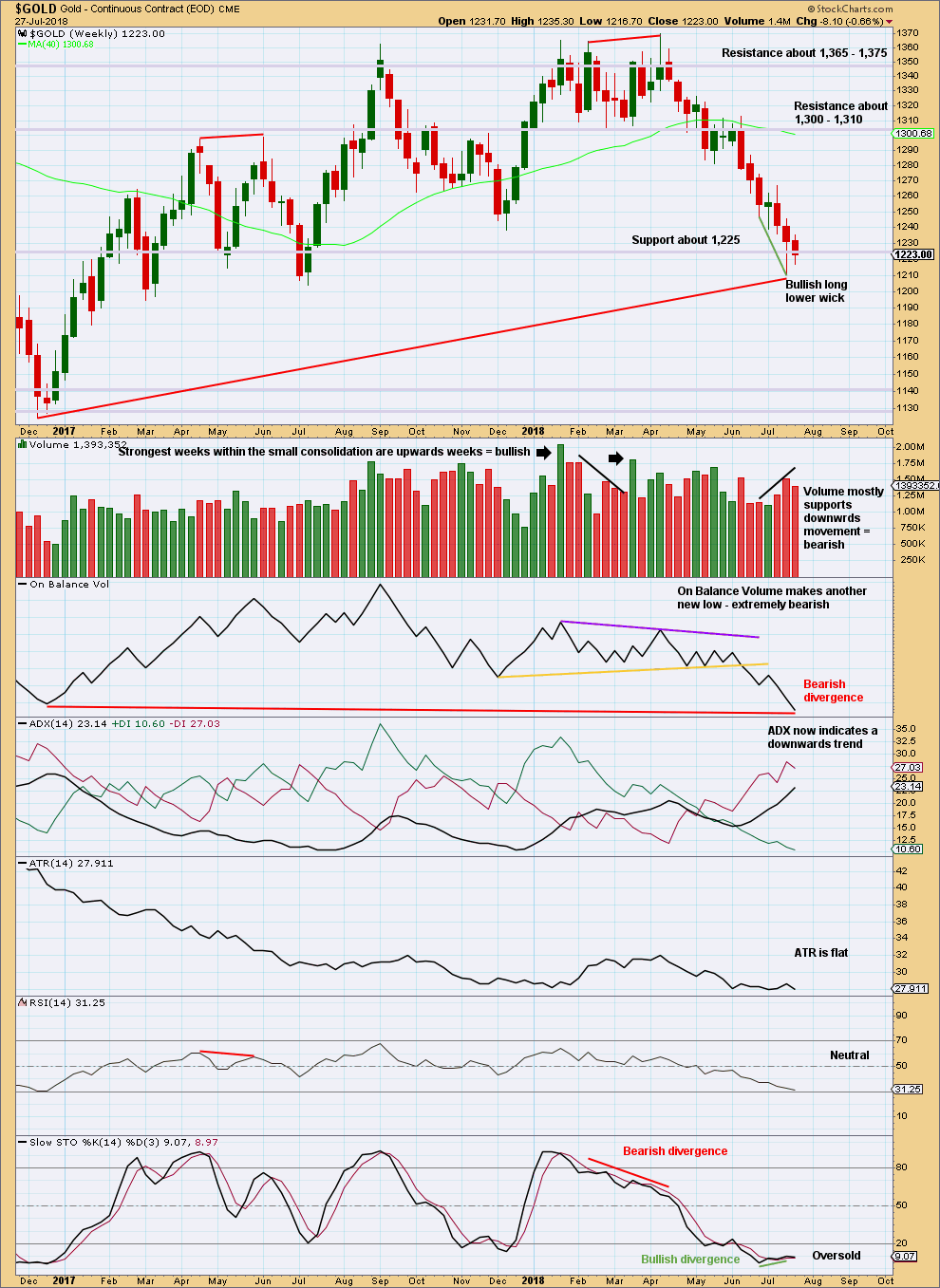
Click chart to enlarge. Chart courtesy of StockCharts.com.
On Balance Volume last week makes another new low. This new low is below the prior low of the week beginning 12th of December, 2016. This divergence is bearish.
Slightly lighter volume for an inside week is very slightly bullish for the short term.
DAILY CHART
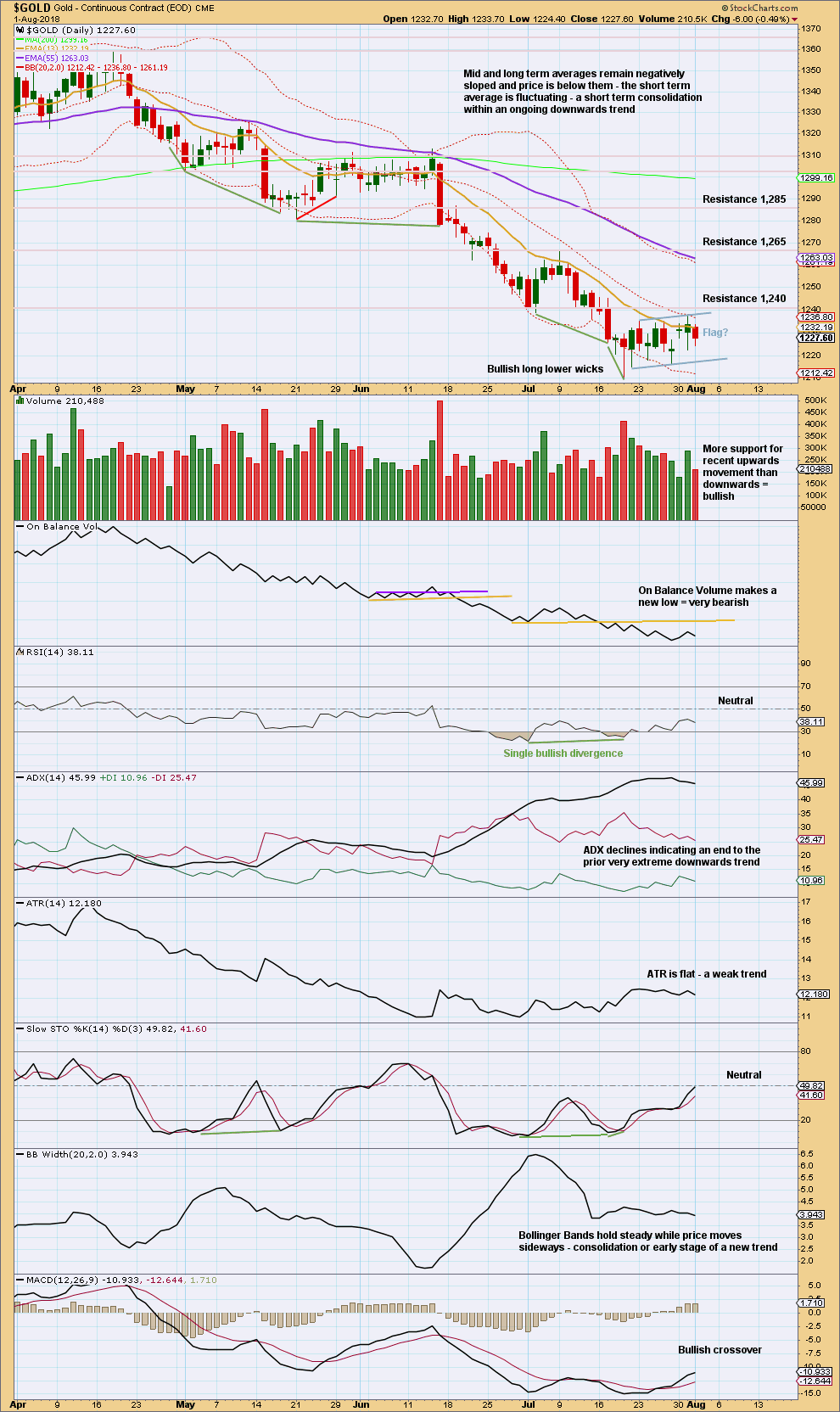
Click chart to enlarge. Chart courtesy of StockCharts.com.
A flag pattern may now be forming; these are reliable continuation patterns. Volume during the pattern though is strongest for an upwards day, contradicting the continuation implications of the pattern.
Some good support from volume for upwards movement may be a warning that the flag pattern may be about to fail. A close above about 1,238 with support from volume now would be an upwards breakout from the pattern. It would at that point be considered to have failed and a low in place would be expected.
Volume does normally decline during the formation of flag patterns. The best flags are no longer than 15 days in duration. So far this one has lasted nine days. A target using the measured rule would be about 1,160.
The new low four sessions ago from On Balance Volume is extremely bearish.
However, ADX had reached very extreme indeed. While it can reach very extreme for this market, it is at this time nearing as extreme as it was in early August 2015. At that point, price was in an extreme downwards trend that was relieved by a bounce of $106.42 lasting 58 days.
If a low is not yet in place, then it may be reasonably soon.
GDX WEEKLY CHART
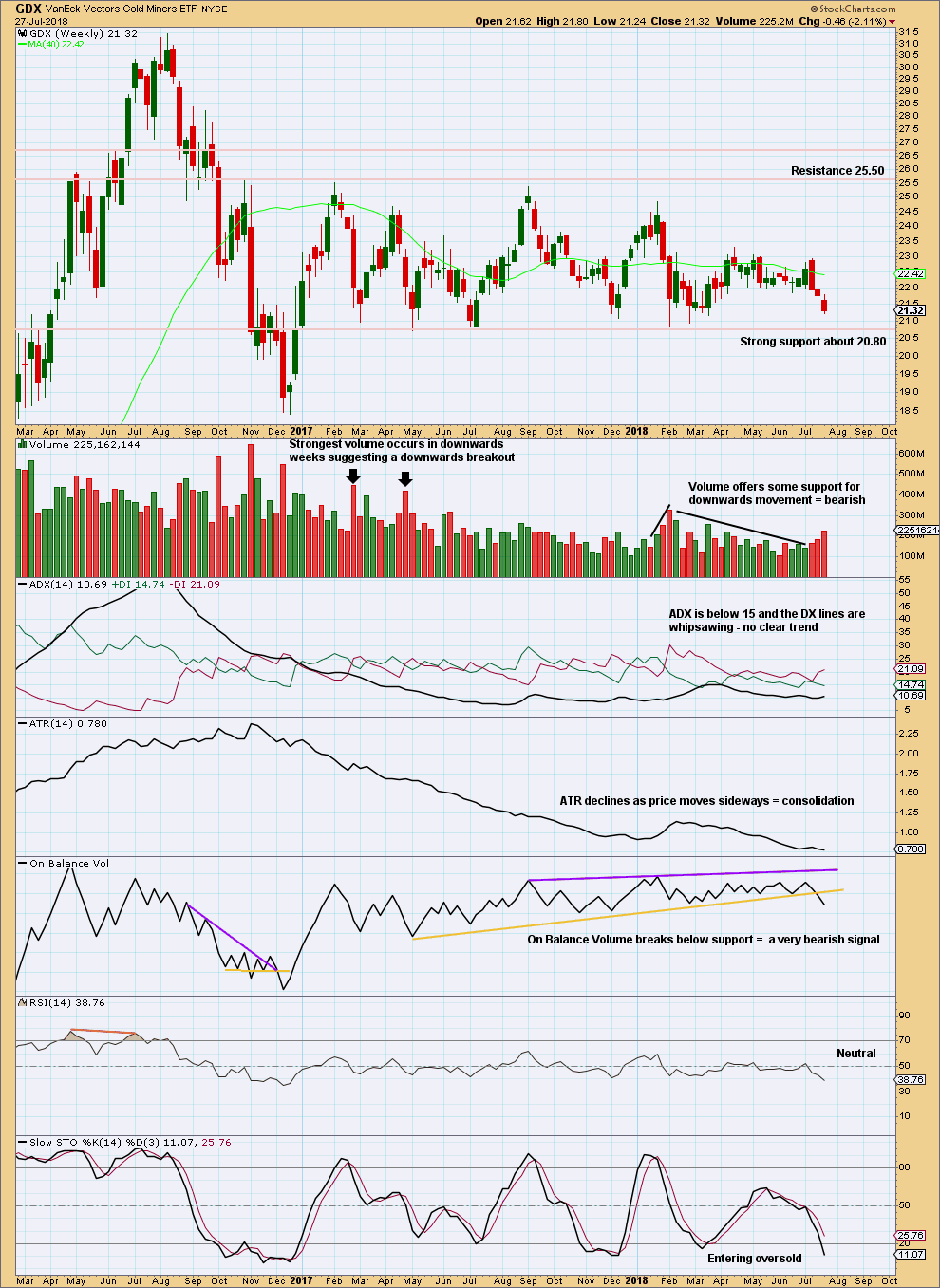
Click chart to enlarge. Chart courtesy of StockCharts.com.
GDX has been range bounce since January 2017. This is a very long sideways consolidation. The longer it continues, the more sustained the eventual breakout will be. Volume suggests the breakout may more likely be downwards.
Support about 20.80 has been tested about eight times and so far has held. The more often a support area is tested and holds, the more technical significance it has.
With a very bearish signal now from On Balance Volume and support from volume for falling price, look out not only for a test (again) of support about 20.80 but also for a possible break below this point. A close below 20.80 would be extremely bearish. Expect then to see GDX likely to continue in a strong downwards trend to new lows that may last over a year.
GDX DAILY CHART
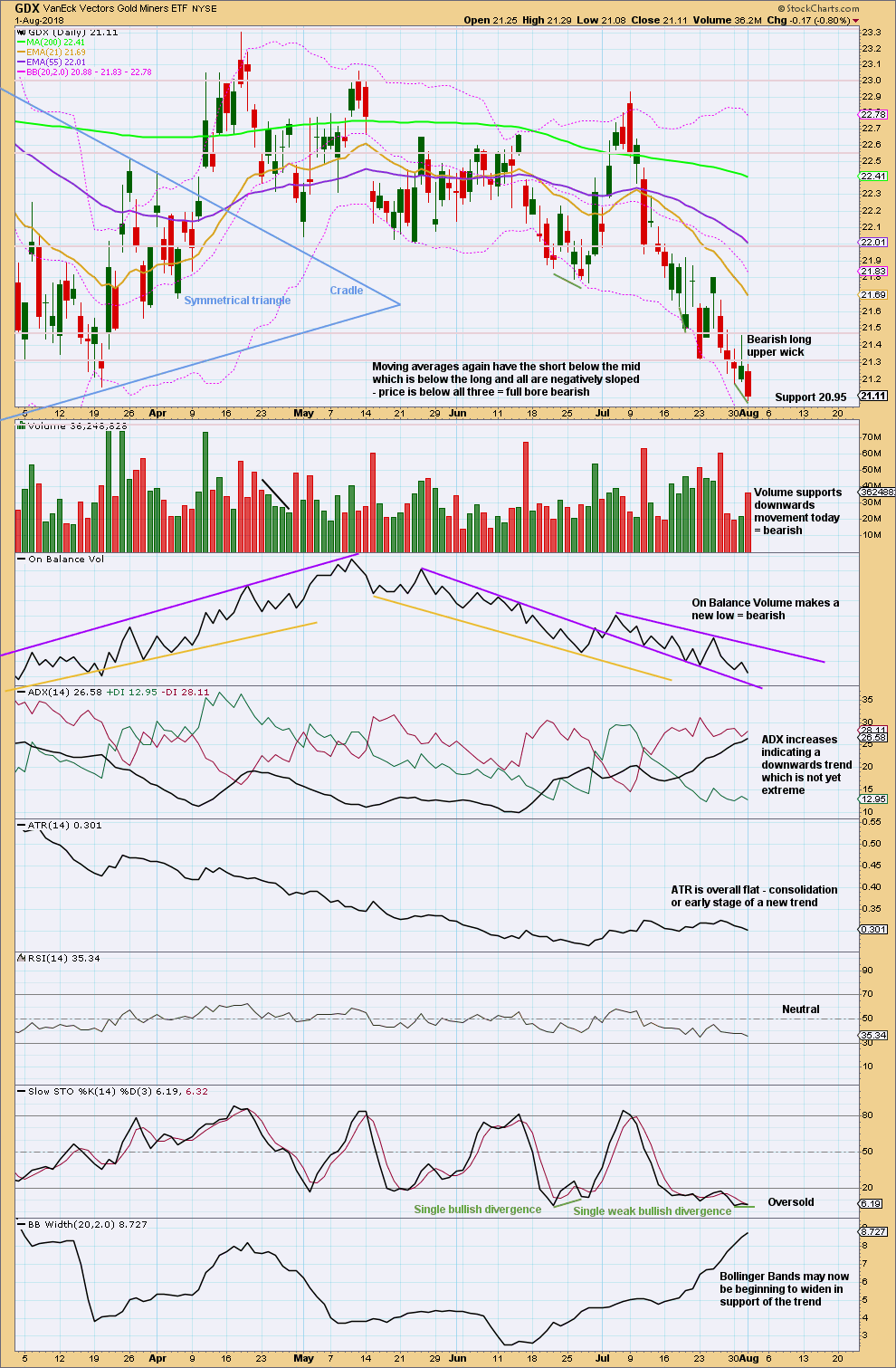
Click chart to enlarge. Chart courtesy of StockCharts.com.
Stochastics may remain oversold for reasonable periods of time during a trend. Currently, this market is trending downwards.
Price has closed below 21.30. Look for first support about 20.95, and then just below that look for very strong support about 20.80.
In the first instance, expect resistance now about 21.30 and above that about 21.45.
Published @ 09:45 p.m. EST.

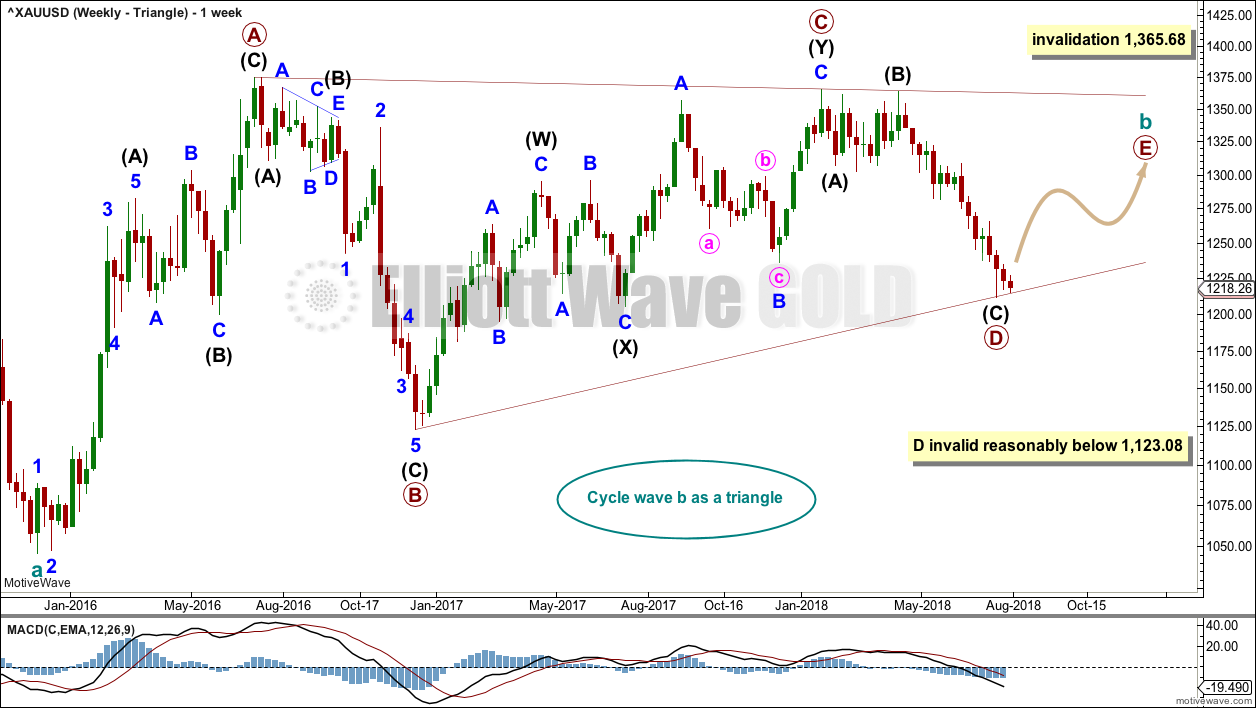
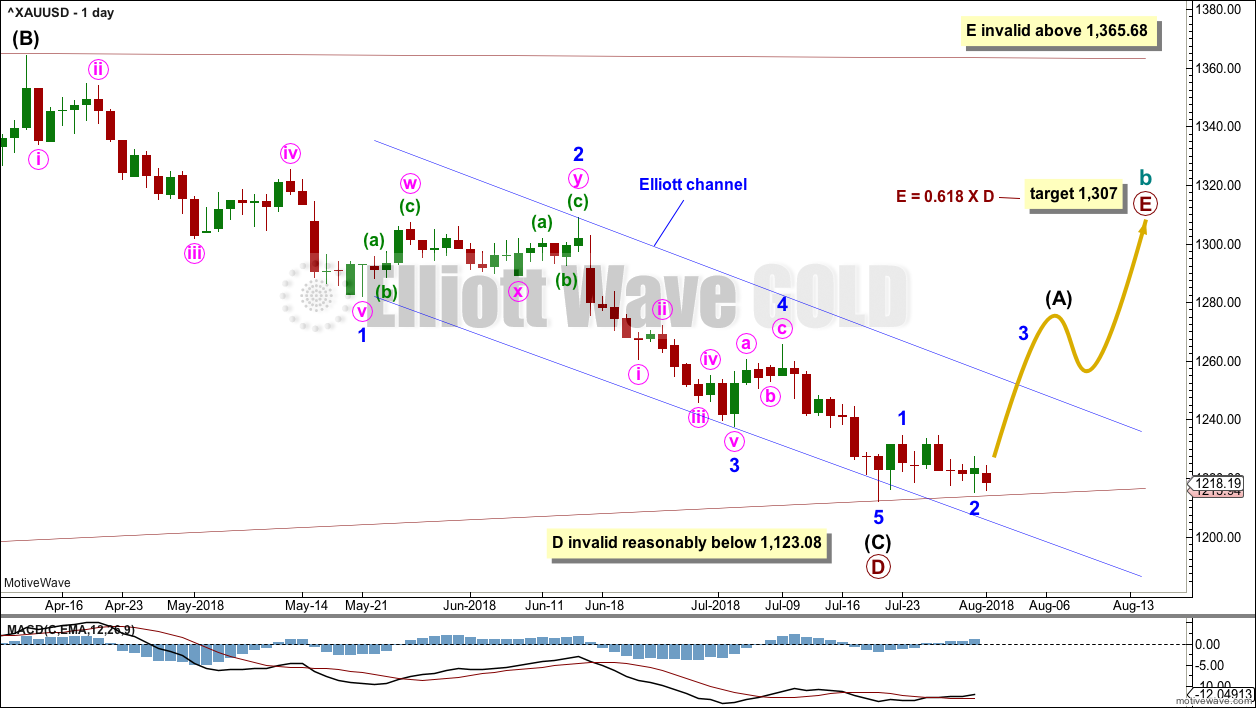
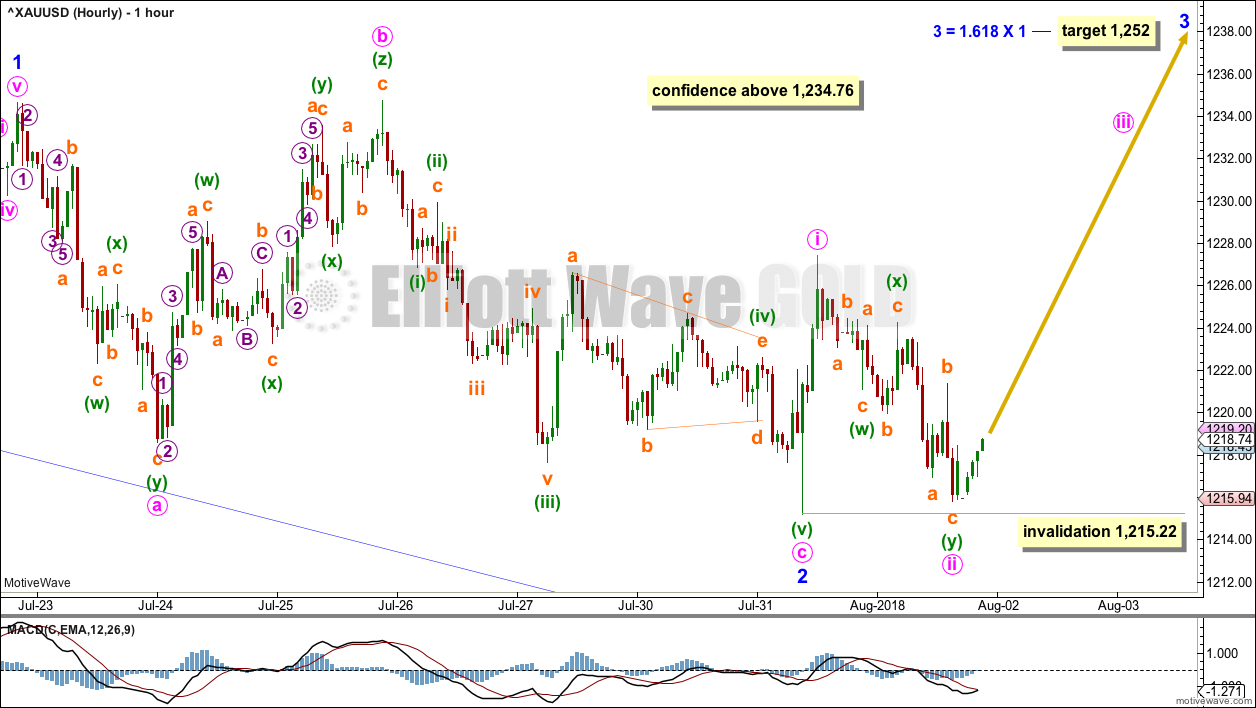
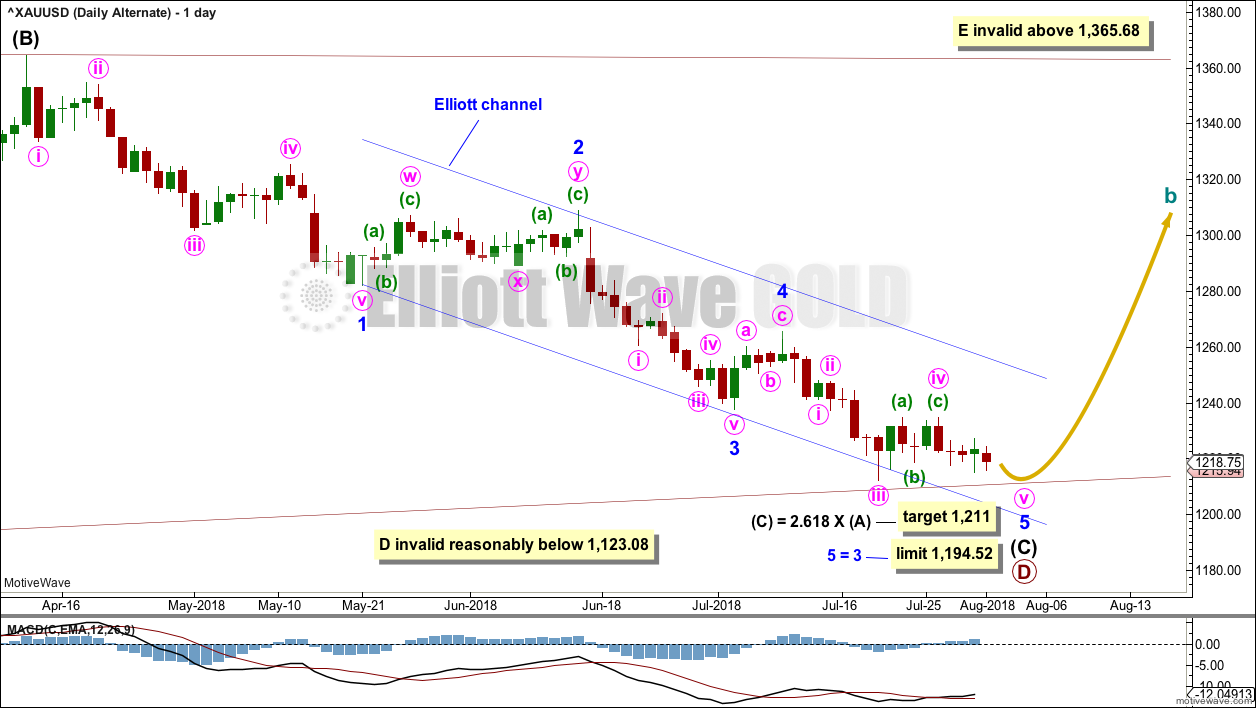
the main hourly is invalidated by a new low
obviously primary D is not over, it is continuing lower.
within minor 5: minute v has now reached equality in length with minute i and the structure is incomplete. the next Fibonacci ratio in the sequence is used for the next target at 1,196.
the flag pattern gives us a measured rule target at 1,160.
about one of these targets we may finally find a low.
Gold made new lows as suspected. Silver has not made new lows. Miners holding up pretty good. ABX which has sold off hard since earnings is near flat today. Sellers are running out of ammo.
This divergence/ relative strength suggests a low is near. Economic data release on Friday AM could be the turning point!
Watching what I think is an ending diagonal play out in the $USD. If correct, this adds confidence that the bottom for Gold is either in or very close.
So it looks like the $USD has about 1.0 to go up to complete the pattern before a large drop starts. So the question is: Can Gold decouple from the $USD during this final rise? If so, the bottom may be in for Gold. If not, Gold may have one final low coming in the next 2-3 days. Stay tuned…
https://www.tradingview.com/x/bncTlECm/
Tricky right? (at least for an ETF trader – non-24hrs). If this is not triangle, could be in midst of commodity extended 5th down?